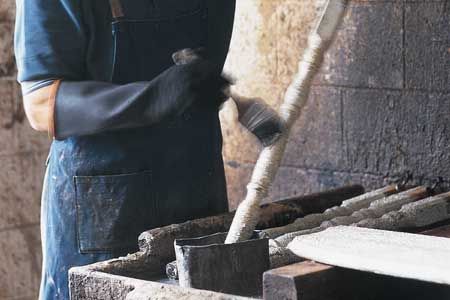Stripping furniture can reveal the natural beauty of wood grain hidden beneath layers of paint or varnish. It’s also a great way to restore antique pieces to their original glory or prepare furniture for a new finish. Stripping is also necessary when paint is cracking, peeling, or in poor condition. Our guide walks you through the process, from finish types to preparation and application.
Types of Paint and Finishes
Furniture can be coated with various types of paint and finishes, including latex paint, oil-based paint, lacquer, shellac, and varnish. Each type may require different stripping techniques or chemicals. Identifying your piece’s finish can help you choose the most effective stripping method.
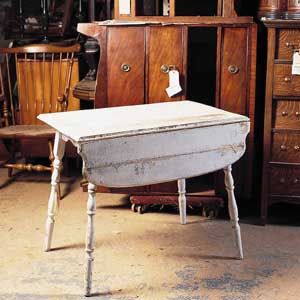
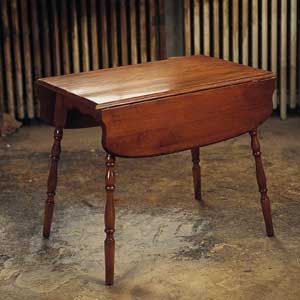
Tools and Materials for Stripping
To successfully strip your painted furniture, you’ll need the right tools and materials.
Safety Equipment
Safety should be your top priority during your project. Essential safety gear includes:
- Chemical-resistant gloves
- Organic solvent respirator mask with new filters
- Protective apron
- Splashproof goggles
Stripping Tools
The following tools will help you apply stripper and remove paint:
- Metal scrapers
- Natural-bristle paintbrushes (cut down for scrubbing)
- Plastic scrub brushes for intricate areas
- Putty knives
- Steel wool or abrasive pads
Chemical Strippers
There are several types of chemical strippers available:
- Medium-fast strippers with fewer toxic chemicals
- Methylene chloride-based strippers (fastest-acting but most toxic–we don’t recommend these unless you need the project done as quickly as possible)
- Refinishers for shellac or lacquer finishes
- Slow-acting, environmentally friendly strippers
Choose a stripper based on your project needs and safety concerns.
Preparing Your Workspace for Stripping
Preparing your workspace will set you up for a successful and safe stripping project. When possible, select a well-ventilated area for your project, such as a garage or outdoor space, to get adequate ventilation.
“Because many chemicals in strippers are heavier than air, they will sink to the floor and can be difficult to get rid of, so basements are not a good choice,” says Don Maxwell of Maxwell’s Furniture Restoration.
Set Up Your Work Area
Create a dedicated stripping station by taking the following steps:
- Cover your work surface with thick layers of newspaper
- Keep a trash can nearby for easy disposal of used materials
- Make you have proper lighting to see all the details
- Use a lipped metal tray to collect excess stripper for reuse
Step-by-Step Guide to Stripping Painted Furniture
Each of the following steps is necessary for getting a clean, smooth surface ready for refinishing.
Remove Hardware and Make Repairs
Start by removing all hardware from the piece. Number the parts or take photos to help with reassembly later. If the furniture needs repairs, get that done before stripping. For example, fix splits or loose joints to make sure the piece is structurally sound.
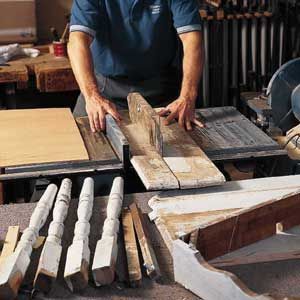
Apply Chemical Stripper
Using a natural bristle brush, apply a thick, even coat of stripper to the furniture. Work in small sections to prevent the stripper from drying out. For vertical surfaces or stubborn finishes, consider using a paste-type stripper that stays wet longer.
Scrape and Remove Paint
Once the paint begins to bubble and lift, use a putty knife or scraper to remove the loosened paint. “The only trick to stripping is to treat every element making up a piece of furniture in exactly the same manner,” ” says Maxwell. This helps the stain and finish absorb evenly later.

Clean and Neutralize the Surface
After removing the bulk of the paint, use a stripper rinse or denatured alcohol to clean the surface. This step removes any remaining chemical residue that could interfere with the new finish. Allow the piece to dry thoroughly before proceeding.
Dealing With Intricate Details and Carvings
Intricate details and carvings require special attention during the stripping process. These areas often hold stubborn paint and can be challenging to clean without damaging the wood.
Techniques for Stripping Curved Surfaces
For curved surfaces, use flexible scrapers or steel wool to conform to the shape. Apply the stripper liberally and allow it to work into the contours before gently scraping or scrubbing.
Removing Paint from Crevices and Corners
Maxwell recommends using a scrub brush to work paint out of nooks and crannies on furniture legs, but that’s not the only option. Try the following methods:
- Trying dental picks or wooden skewers for precision work
- Using coarse twine or wood shavings to scrub out paint
- Using a small, stiff brush to work stripper into crevices
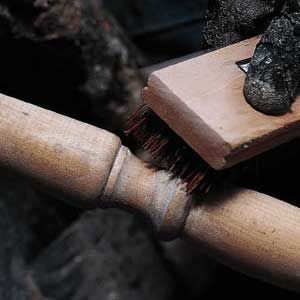
Sanding and Smoothing the Stripped Surface
After stripping, sanding is often necessary to achieve a smooth surface ready for finishing. Approach this step carefully to avoid damaging the wood.
When to Sand
Sand the furniture once it’s completely dry from the stripping process. This removes any remaining finish and smooths out raised grain caused by the stripping chemicals.
Choosing the Right Sandpaper
Start with a 100-grit sandpaper and progressively move to finer grits if needed, although Maxwell cautions against over-sanding: “If a piece is getting a surface finish, using 100-grit sandpaper is sufficient.”
For final smoothing, use a small cork-padded block to avoid leaving swirl marks that could show through the new finish.
Sanding Tips and Techniques
Sanding is essential for smoothing out the surface and preparing it for the final finish. When sanding, always move in the direction of the wood grain to avoid scratches that could become visible under the finish. Use even pressure and frequently check the surface to make sure you’re not over-sanding. For pieces with intricate details, consider using fine-grit sanding sponges, which can conform to the shape of your furniture.
Finishing Options for Stripped Furniture
Once your furniture is stripped and sanded, you have several options for finishing. The choice depends on the look you want to achieve and the wood’s characteristics.
Staining Techniques
If you’re staining the wood, consider these tips:
- Apply stain with a brush or cloth, working with the grain
- For uneven wood tones, use different strengths of stain to blend colors
- Test the stain on an inconspicuous area first
Maxwell suggests blending stains for a uniform look: “The key to blending the two areas is to always brush from a wet edge.”
Select the Right Stain
There are a number of stains available, such as oil-based, water-based, and gel stains. Oil-based stains penetrate deeply and are durable, while water-based stains are easier to clean up and quick-drying. Gel stains are thick and provide a uniform color, especially useful for woods with uneven grains. Choose a stain that complements the type of wood you chose and the look you’re aiming for.
Protective Topcoats
After staining, apply a protective topcoat. Options include:
- Lacquer for a smooth, professional finish
- Oil-based finishes for a more traditional look
- Polyurethane for durability on high-use pieces
Choose a finish that balances style with the furniture’s intended use.
Applying Topcoats
When applying a topcoat, use long, smooth strokes and avoid over-brushing to prevent streaks and bubbles. Depending on the type of finish, you may need to apply multiple coats, sanding lightly between each coat to ensure a smooth, even surface. For added protection, especially on tabletops or surfaces that see heavy use, consider applying a final coat of polyurethane.
Common Stripping Challenges
Stripping furniture can present various challenges, but being prepared for these issues will help you handle them successfully.
Stubborn Paint Removal
For particularly stubborn paint, try these tips:
- Apply a second coat of stripper
- Consider using a heat gun, but be cautious to avoid scorching the wood
- Use a stronger chemical stripper if needed
Preventing Wood Damage
Here’s some guidance to protect the wood during stripping:
- Avoid over-scraping or aggressive sanding
- Be extra careful around veneers and delicate inlays
- Use plastic tools on softer woods to prevent gouging
Dealing With Warped Wood
In some cases, older furniture may have warped wood due to age or previous exposure to moisture. If you encounter warped wood, it may need to be rehydrated and clamped flat until it dries out. Be patient and avoid forcing the wood, as it could crack or split further.
Environmental Considerations and Safety Precautions
When stripping furniture, keep personal safety and environmental impact in mind.
Proper Disposal of Stripping Waste
Dispose of stripping waste according to local regulations:
- Check with your local waste management facility for proper disposal methods
- Collect paint scrapings and used stripper in sealed containers
- Never pour chemicals down drains or onto the ground
Ventilation and Personal Protection
Always prioritize safety with these tips:
- Take frequent breaks to avoid overexposure to fumes
- Wear all recommended safety gear throughout the process
- Work in a well-ventilated area or use fans to improve air circulation
Environmental Impact
Use eco-friendly strippers and solvents whenever possible. These products often contain fewer harmful chemicals and are safer for you and the environment. Consider using reusable tools and equipment to minimize waste.
